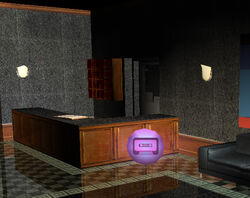
Save points are locations where the player goes to save their progress in a Grand Theft Auto game. Because the player cannot save the game by simply accessing the game's menu, the use of save points is required for this purpose.
History
Design
The physical locations and accessibility of save points vary throughout the games. The concept of save points was first explored in Grand Theft Auto 2, where the player is offered the option to enter a "church" (hilariously marked by a JESUS SAVES sign) in each of Anywhere City's three districts. When in the church, the player must have at least $50,000 in hand to donate to the church and have their "soul saved", otherwise, the player will be turned away until they have $50,000.
Safepoints from Grand Theft Auto III onwards require no payment for use, as they are primarily hideouts provided by an acquaintance, free of charge, or are already the player's property. In GTA III, the player walks into a building to save, but the buildings' interior is not primarily visible. In Grand Theft Auto: Vice City, Grand Theft Auto: San Andreas, Grand Theft Auto: Liberty City Stories, Grand Theft Auto: Vice City Stories, Grand Theft Auto IV and Grand Theft Auto V, the interiors become visible, and safehouses are introduced. Savehouses from GTA Vice City onwards also replenish the player's health for each save. Accessing a save point may also clear any Wanted Level (even if you quit without saving, in some games). On mobile versions of the GTA games, the game automatically saves as soon as the player completes a mission or is ready to quit the game, thus leading the character to spawn wherever the player was when the game was closed regardless of them walking into a save icon.
Save icons
Save icons, which were first introduced in GTA Vice City, are floating icons which the player must walk onto, to save the game, allowing save points to be placed indoors or outdoors. The icons were originally modeled after many other pickup icons in GTA III and GTA Vice City, depicted floating and spinning as a result. They vary in appearance between games, and are reminiscent of the media used in time period in which the game is set:
- In GTA Vice City, set in 1986, save icons are represented by pink tape cassette icons.
- In GTA San Andreas, set in 1992, save icons are represented by blue 3.5" floppy disks, with the GTA San Andreas logo on the labels.
- In GTA Liberty City Stories, set in 1998, save icons are represented by Compact Discs. On the PSP version, it shows with the words "No.1 backup" on one side, and on both sides in mobile versions.
- In GTA Vice City Stories, set in 1984, save icons are represented by 5.25" floppy disks, with the GTA Vice City Stories logo on the labels.
GTA Vice City Stories is the latest game to adopt the save icon, as beds in safehouses effectively replace the icon in GTA IV.
Savehouses
"Savehouses", or safehouses, are buildings where the user can save their game, and are a specialized subset of save points that offer additional amenities to the player. Whereas save points typically consist of no more than a point to save a game, a safehouse offers clothing options, and in many cases, garages for vehicle storage. It is important to note that while all save points in GTA San Andreas are categorized as safehouses, certain safehouses offer no more than floating save icons, making them more of save points than safehouses in a technical sense.
From GTA Vice City onwards, safehouses offer a change of clothing in addition to the save icon; in GTA San Andreas, GTA Liberty City Stories, GTA Vice City Stories, GTA IV, The Ballad of Gay Tony and GTA V, safehouses offer a full wardrobe in which to change the protagonist's clothing. GTA IV and GTA V also employ an auto-save feature after the player has passed certain missions or performed certain activities. Saving the game from GTA III and onwards advances the time by 6 hours. In GTA V, time will advance 6 hours saving as Michael, 8 as Franklin and 12 as Trevor.




